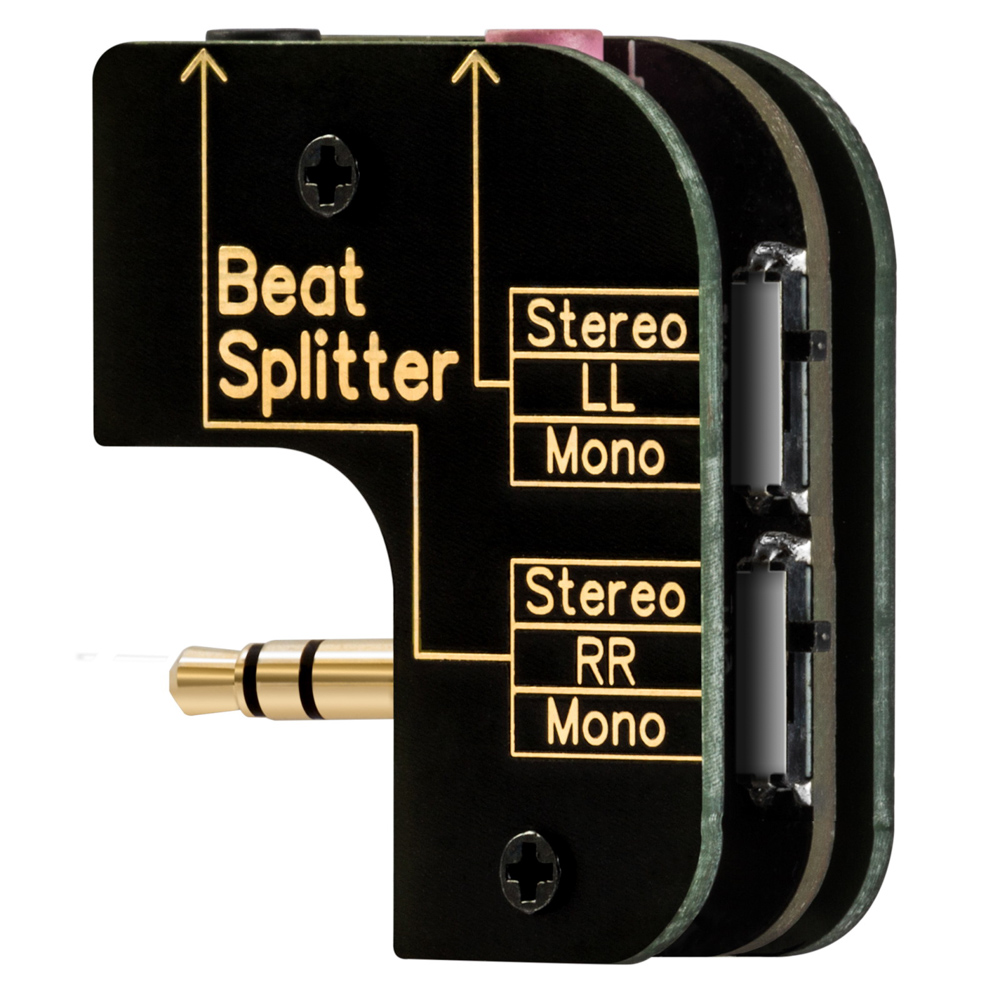myVolts - Beatsplitter
Artnr: IDS0120402
Tarneaeg: 2-7 tööpäeva.
Teave:
The Beatsplitter is a single to dual stereo splitter with switchable channels.
It can duplicate outputs, but it can also merge inputs. Which signals appear on each channel is determined by how a small switch is set on the side of the unit.
On the Left channel, in can be set to Stereo, LL (Left, Left) and Mono. On the Right channel, it can be set to Stereo, RR (Right Right) and Mono.
In output mode, the stereo cable plugged into the unit has a Left and Right signal. If the output is set to LL, then the Left channel signal from the input is duplicated to both Left and Right sides of one output, creating a false stereo. The same can be achieved with the Right input signal, by setting the Right sided output to RR.
In input mode, the Left channels from each of the two inputs are merged onto the Left channel of the output when switched to LL. The same happens for the Right channels when switched to RR.
What does the Beat Splitter do?
The Beat Splitter allows you to manage the signals to your desired outcome. In practical terms, it solves channel mis-match problems, for example, did you ever want to…
Share an output of your jam with a second person with headphones? Whether you want to share the output of a player, or a mini-synth like a PO, or duplicate the output of your summing mixer, this very easily achieved.
Have a second output to record any of the above on a recorder, or even bluetooth send it to a camera or phone. The convenience of being able to "get in" at any point in your setup means greater flexibility when recording.
But I can do those things with a standard splitter cable, is there anything else it can do?
Get a true stereo output to two independent speakers. For example, if you wished to take a laptop audio output and send L and R channel independently to a Left and Right speaker, true separation is achieved. You can send a LL to one speaker and RR to the other. This will be far better than a stereo splitter cable, which will give you a LR on both speakers, or a stereo to mono cable, which will give you a L Mono and R Mono on each speaker.
Create a stereo effect when you want it. There are numerous situations where audio will end up only on one side of your headphones, or worse, one side of your mix in recording. These include, when your guitar, or violin pick-up only outputs Mono, or when you run your keyboard through a Mono effects pedal. Using the LL output, you can "stereo-fy" your Mono output, by creating a false stereo duplication of the channel.
Allow yourself to easily record on two channels with one input. If you wanted to record an interview, but have only a single input stereo recorder, Beat Splitter makes it possible to record the two voices independently. For example, a smartphone with audio input jack could have the beatsplitter attached, then a mic could be plugged in to each of the two inputs, set to LL and RR, the phone would record person A on L channel and person B on R channel. This would obviously work with any two channel recording requirement, with synths, guitar and voice, etc.
Avoid Sync "hammer" in your mix. A lot of small synths have intelligent systems for clock control, usually existing on the Left side of your stereo connection. Avoiding this in your mix is possible with the Beat Splitter. For example, using a Pocket Operator as sync master to control a Korg Volca slave. One Beat Splitter channel has output audio, the other outputs sync. This can be also be achieved with a stereo to dual mono cable, but if you do, you will most likely end of with your PO audio on one channel, as in the point above.
For desktop synths, manage audio independently from sync to avoid distortion from multiple pass-throughs and allow recording on independent tracks. The suggested method for connecting a number of Pocket Operators, is to run them in a train, each passing sync and audio on to each other. Each pass-through requires the adding of gain, which can provide significant noise and distortion as it passes through multiple amplifications. This also removes the possibility of individual volume control per PO and the recording of the POs outputs as individual tracks. With Beat Splitter, all these limitations and difficulties are removed.
Can TAPS be combined?
Yes, they can be combined, they are also stack-able, you can plug a Beat Splitter into a PO, then plug a PnP into one of its outputs. These configurations solve other problems, such as…
Wet/Dry effects on your tabletop. If you want to duplicate your audio output from a device (with Beat Splitter), then you can run a cable through an effects unit (e.g. Korg Monotron), put a PnP on its output and you get a Wet/Dry version of the effect by turning the pot in Volume mode.
You can A/B test two sources of of a input to a mix. Just set up like point 5 above, then use a PnP to pan between the two inputs.





















































































